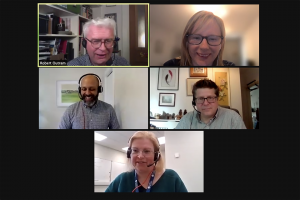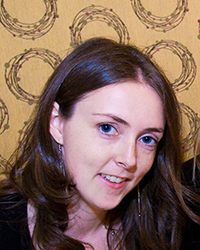Webinar addressed the cost of adapting to climate change as well as mitigation strategies and emerging business opportunities

Aquaculture is vulnerable to the growing impacts of extreme weather and climate change but as the challenges arise, so do unique business opportunities, according to panelists of a webinar on climate change and the growing global industry.
On Aug. 19, Fish Farmer Magazine and online content business InterMet presented “Aquaculture – Meeting the Threats of Extreme Weather & Climate Change,” a timely discussion given the upcoming UN Climate Change Conference of the Parties (COP26) in Glasgow. It also follows an alarming report from the International Panel on Climate Change (IPCC), stating that global warming is likely to rise around 1.5 degrees-C within the next 20 years and there’s a short window to prevent the worst effects on the planet.
Over two hours, the expert panel shared their thoughts on these climate-related threats for the aquaculture sector, as well as mitigation strategies and possible solutions.
‘A solid risk management plan is more important than ever’
Panelist Daniel Fairweather said, “climate change is on the lips of everyone in the insurance world.” Speaking from his experience as the head of livestock, aquaculture and fisheries with insurance company Gallagher, he discussed how losses in the aquaculture sector continue to grow as disease and extreme weather events result in significant losses to insurers. Furthermore, investors are increasingly using exposure to climate change as a key metric in investment decision-making.
“Unfortunately, we’ve seen that the aquaculture and insurance industries have suffered from huge losses,” said Fairweather. “It’s resulted in a reduction in insurance capacity and a changing mindset [about risk].”
As companies will increasingly be forced to “bear a larger portion of the risk themselves,” Fairweather stressed the importance of implementing robust, intelligence-based risk management plans that will lead to a reduction in expected risk. He also spoke briefly about novel insurance products, such as parametric insurance and “cat in a box” insurance, as options.
“There are solutions out there if you find your insurance does change,” said Fairweather.
‘We need to move away from thinking about aquaculture as a general term’
For Dr. Lynne Falconer, a researcher at the Institute of Aquaculture at the University of Stirling in Scotland, moving towards a coordinated, regional-specific approach to dealing with climate-related threats is crucial for aquaculture. Looking at the diversity of salmon farming in Norway, she cautioned against adopting a generalized approach and discussed how climate-related threats vary by location and other factors.
“There are different types of farming and it involves multiple stages,” said Falconer. “Each of the stages is exposed to climate change in a different way. Focusing on only one part of the production stage may actually miss what’s happening at large.”
In terms of identifying key threats to a business, Falconer urged to “start with data.” For future planning, for example, that means identifying knowledge gaps and uncertainties for targeted research or improved data collection, which could ultimately help determine “if something is a threat or not.”
“There’s not a one-size-fits-all approach,” said Falconer. “But more people and companies are going to have to think about the risks to their specific situation and area.”
https://www.aquaculturealliance.org/advocate/quantifying-greenhouse-gas-emissions-from-global-aquaculture/
‘Data is the lighthouse’
The panel also featured Jonathan LaRiviere, chief executive of Scoot Science, an ocean analytics and forecasting business based in Santa Cruz, Calif., USA. He spoke about the financial blow to the aquaculture sector from environmental events, which “tallies into the billions of dollars per year” and excludes extreme events such as Chile’s harmful algae in 2016.
“The risks we think we know about are changing as new climate scenarios unfold before our eyes,” said LaRiviere. “When our team looks at the biggest challenges [for the industry], what we see is that access to new capital is really strained. It stalls expansion that drives the industry towards being a key pillar for providing food security in the world.”
LaRiviere explained how their SeaState analytics platform can help companies “put foundational ocean data to work” and “make oceans manageable, insurable and investible.”
“The platform unifies all the data being collected on farms, the surrounding oceans and the overlying meteorological conditions,” he said. “It gives farms the best opportunity to maximize the lead time that they have and set up their mitigation strategies and try to navigate things like low oxygen or extreme temperatures.”
By gathering data on “underwater weather,” farms can use this ocean forecasting tool for insurance purposes, such as obtaining protection for previously uninsurable risks.
“It gives the ability to be transparent about ocean risks,” said LaRiviere. “Equip the farms for the first time with the risk protection that they need and an understanding of their business that lets them go into the office of a lender.”
https://www.aquaculturealliance.org/advocate/can-underwater-forecasting-promise-loss-prevention-for-fish-farmers/
‘The need for aquaculture to provide food security is crucial’
Anne Anderson, head of sustainability and development with Scottish Sea Farms, one of Scotland’s leading producers of premium farmed salmon, reflected on climate change and aquaculture, using salmon farming in Scotland as a case study. Recognizing that fish farming “as a critical sector,” she discussed three key climate-related threats in Scotland: water scarcity, flooding and storm events, and emerging pathogens from changing temperatures. Despite the hurdles, Anderson emphasized that challenges bring opportunities for the industry.
“Salmon farming is full of individuals rolling up sleeves, diving in, and finding solutions,” said Anderson.
From carbon capture to AI to investing
An hour was also devoted to panelists answering questions from the moderator and the aquaculture sector. Panelists tackled a wide range of tough topics: from the cost of adapting to climate change to how aquaculture can contribute to carbon capture to the role of artificial intelligence in supporting farmers. Watch the recorded webinar here.
Follow the Advocate on Twitter @GAA_Advocate
Now that you've reached the end of the article ...
… please consider supporting GSA’s mission to advance responsible seafood practices through education, advocacy and third-party assurances. The Advocate aims to document the evolution of responsible seafood practices and share the expansive knowledge of our vast network of contributors.
By becoming a Global Seafood Alliance member, you’re ensuring that all of the pre-competitive work we do through member benefits, resources and events can continue. Individual membership costs just $50 a year.
Not a GSA member? Join us.
Author
-

Lisa Jackson
Associate Editor Lisa Jackson lives in Hamilton, Ontario, Canada. Her work has been featured in Al Jazeera News, The Globe & Mail, The Independent, and The Toronto Star.
[103,114,111,46,100,111,111,102,97,101,115,108,97,98,111,108,103,64,110,111,115,107,99,97,106,46,97,115,105,108]

